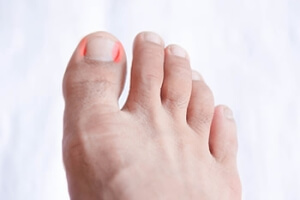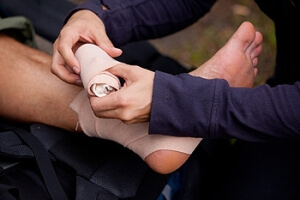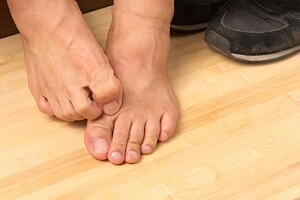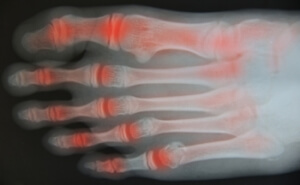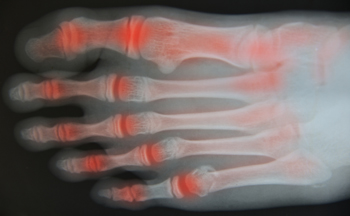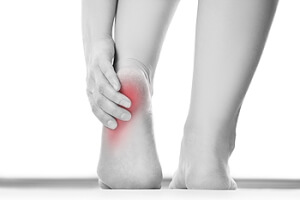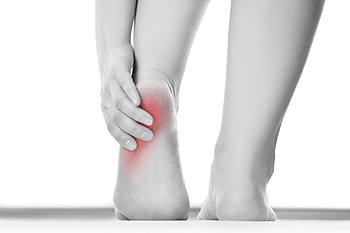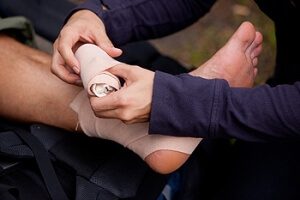Super User
Getting the Right Shoe Size: To Keep Your Feet Happy
People are constantly wearing improperly-fitting shoes. Though it isn’t hard, picking the right shoes does require keeping a few things in mind.
Shoe stores have rulers so you can get an exact measurement of your feet. Be sure to always measure your feet with your shoes on. Measuring just your foot will give you a shoe size that is 1-2 inches too small for picking the right size shoe.
To ensure that your toes won’t be cramped, make sure there is wiggle room. Approximately one inch should be between your toes and the tip of your shoe. It is easy to tell if your shoes are too tight, because you will start to experience pain, blisters, and swelling.
Additionally, do not always assume your shoe size will be the same at every store. Manufacturers sometimes run differently, and your size will vary from brand to brand. Make sure the stores you purchase from have return policies, in case there is a problem.
Rather than shoe shopping in the morning, it is advised to shop for shoes later in the day. Your feet will swell as the day passes. If shoes are purchased in the morning, they may not be as snug as they should be. Furthermore, not all two feet are the same size. Therefore, accommodations may be necessary.
An overall concern in buying shoes is making sure they are comfortable and supportive. There is no such thing as a shoe being ‘broken in’. If they are uncomfortable at the store, they likely will always be uncomfortable.
Since we do a lot of walking, it is important that we pick the right shoes. Our feet will benefit from this, and we will be happier and healthier because of it.
Dealing with Ingrown Toenails
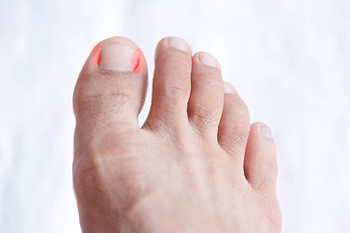
Ingrown toenails occur when the toenail grows into the surrounding skin, usually at the side of the nail. This is an irritating and painful annoyance that can also cause the skin to become red and swollen. What can make an ingrown toenail worse is if the skin breaks and bacteria enters the skin, causing an infection, drainage and an unpleasant odor. This is potentially dangerous for individuals with diabetes, poor circulation, or nerve damage. Ingrown toenails usually develop from improper toenail grooming. Toenails should always be trimmed straight across (never curved), and they should not be cut too short. Keeping nails flush with the tip of the toe is suggested, as anything shorter may encourage the nail to grow into the skin, not over it. Other risk factors for an ingrown toenail include experiencing trauma/injury to the toenail, wearing shoes that are too short or tight, inheriting a predisposition to ingrown toenails, or having a fungal toenail infection. If you have an ingrown toenail, contact a podiatrist who can relieve your symptoms, address any possible infection, and help avoid future ingrown toenails.
Ingrown toenails can become painful if they are not treated properly. For more information about ingrown toenails, contact one of our podiatrists of New Tampa Foot & Ankle. Our doctors can provide the care you need to keep you pain-free and on your feet.
Ingrown Toenails
Ingrown toenails occur when a toenail grows sideways into the bed of the nail, causing pain, swelling, and possibly infection.
Causes
- Bacterial infections
- Improper nail cutting such as cutting it too short or not straight across
- Trauma to the toe, such as stubbing, which causes the nail to grow back irregularly
- Ill-fitting shoes that bunch the toes too close together
- Genetic predisposition
Prevention
Because ingrown toenails are not something found outside of shoe-wearing cultures, going barefoot as often as possible will decrease the likeliness of developing ingrown toenails. Wearing proper fitting shoes and using proper cutting techniques will also help decrease your risk of developing ingrown toenails.
Treatment
Ingrown toenails are a very treatable foot condition. In minor cases, soaking the affected area in salt or antibacterial soaps will not only help with the ingrown nail itself, but also help prevent any infections from occurring. In more severe cases, surgery is an option. In either case, speaking to your podiatrist about this condition will help you get a better understanding of specific treatment options that are right for you.
If you have any questions please feel free to contact our office located in Wesley Chapel, FL . We offer the newest diagnostic and treatment technologies for all your foot and ankle needs.
Preventing Foot Problems in Children
 Parents can help their children prevent foot problems and associated pain as they age by taking care of and teaching their children to take proper care of their feet. Developing healthy foot habits in children starts with parents washing their children’s feet each day and making sure they are dry, buying shoes that fit properly (with enough room in the toe box to allow for growth), using right sized cotton and/or wool socks on children’s feet to keep them warm and allow room for development, cutting toenails straight across and not too short to prevent ingrown toenails, and allowing children to go barefoot in the home so their feet will grow and gain strength without restriction. Taking children to a podiatrist early on can start them off right, provide a baseline for their foot development, and introduce them to a specialist who will be able to diagnose and treat any foot problems that might arise in their lives.
Parents can help their children prevent foot problems and associated pain as they age by taking care of and teaching their children to take proper care of their feet. Developing healthy foot habits in children starts with parents washing their children’s feet each day and making sure they are dry, buying shoes that fit properly (with enough room in the toe box to allow for growth), using right sized cotton and/or wool socks on children’s feet to keep them warm and allow room for development, cutting toenails straight across and not too short to prevent ingrown toenails, and allowing children to go barefoot in the home so their feet will grow and gain strength without restriction. Taking children to a podiatrist early on can start them off right, provide a baseline for their foot development, and introduce them to a specialist who will be able to diagnose and treat any foot problems that might arise in their lives.
Making sure that your children maintain good foot health is very important as they grow. If you have any questions, contact one of our podiatrists of New Tampa Foot & Ankle. Our doctors can provide the care you need to keep you pain-free and on your feet.
Keeping Children's Feet Healthy
Having healthy feet during childhood can help prevent medical problems later in life, namely in the back and legs. As children grow, their feet require different types of care. Here are some things to consider...
Although babies do not walk yet, it is still very important to take care of their feet.
Avoid putting tight shoes or socks on his or her feet.
Allow the baby to stretch and kick his or her feet to feel comfortable.
As a toddler, kids are now on the move and begin to develop differently. At this age, toddlers are getting a feel for walking, so don’t be alarmed if your toddler is unsteady or ‘walks funny’.
As your child gets older, it is important to teach them how to take care of their feet.
Show them proper hygiene to prevent infections such as fungus.
Be watchful for any pain or injury.
Have all injuries checked by a doctor as soon as possible.
Comfortable, protective shoes should always be worn, especially at play.
If you have any questions please feel free to contact our office located in Wesley Chapel, FL . We offer the newest diagnostic and treatment technologies for all your foot and ankle needs.
What Happens if You Don’t Treat an Ankle Sprain?
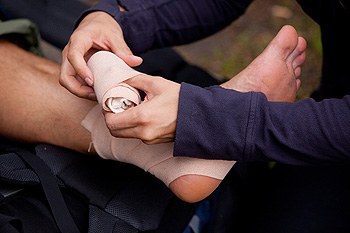 Ankle sprains are one of the most common foot and ankle injuries that podiatrists treat. They occur when one or more ligaments in the ankle are overstretched or torn. If you have sprained your ankle, it is suggested that you seek treatment, particularly if the sprain is moderate or severe. Leaving an ankle sprain untreated can have potentially lifelong consequences. An untreated ankle sprain can lead to weakness in the ankle joint, causing chronic pain and ankle instability that makes repeated injuries more likely. Soft tissues in your ankle could also become trapped between the injured ligament and a bone, resulting in further pain, weakness, and difficulty walking. Swelling caused by an ankle sprain may damage surrounding nerves, muscles, and blood vessels if left untreated. If you have sprained your ankle, please seek the care of a podiatrist.
Ankle sprains are one of the most common foot and ankle injuries that podiatrists treat. They occur when one or more ligaments in the ankle are overstretched or torn. If you have sprained your ankle, it is suggested that you seek treatment, particularly if the sprain is moderate or severe. Leaving an ankle sprain untreated can have potentially lifelong consequences. An untreated ankle sprain can lead to weakness in the ankle joint, causing chronic pain and ankle instability that makes repeated injuries more likely. Soft tissues in your ankle could also become trapped between the injured ligament and a bone, resulting in further pain, weakness, and difficulty walking. Swelling caused by an ankle sprain may damage surrounding nerves, muscles, and blood vessels if left untreated. If you have sprained your ankle, please seek the care of a podiatrist.
Although ankle sprains are common, they aren’t always minor injuries. If you need your ankle injury looked at, contact one of our podiatrists from New Tampa Foot & Ankle. Our doctors can provide the care you need to keep you pain-free and on your feet.
How Does an Ankle Sprain Occur?
Ankle sprains are the result of a tear in the ligaments within the ankle. These injuries may happen when you make a rapid shifting movement while your foot is planted. A less common way to sprain your ankle is when your ankle rolls inward while your foot turns outward.
What Are the Symptoms?
- Pain at the sight of the tear
- Bruising/Swelling
- Ankle area is tender to touch
- In severe cases, may hear/feel something tear
- Skin discoloration
Preventing a Sprain
- Wearing appropriate shoes for the occasion
- Stretching before exercises and sports
- Knowing your limits
Treatment of a Sprain
In many cases, the RICE method (Rest, Ice, Compression, and Elevate) is used to treat ankle sprains. However, you should see a podiatrist to see which treatment option would work best with your injury. In severe cases, surgery may be required.
It is important to ask your doctor about rehab options after you receive treatment for your injury. Stretching, strength training, and balance exercises may help the ankle heal while also preventing further injury.
If you have any questions, please feel free to contact our office located in Wesley Chapel, FL . We offer the newest diagnostic and treatment technologies for all your foot care needs.
Three Types of Athlete’s Foot Infection
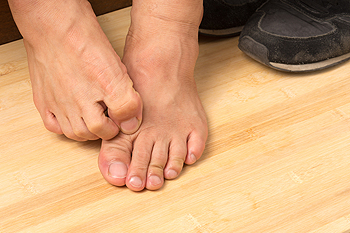 Athlete’s foot is a fungal infection of the skin on the feet. This condition can cause symptoms such as red, dry, peeling, itchy skin, a burning sensation in the feet, blisters, and foul odor. There are three main types of athlete’s foot, named after the areas affected by the infection. A toe web infection affects the skin in between the toes, particularly between the fourth and fifth toes. The skin here typically peels and cracks. A moccasin type infection affects the bottom or heel of your foot, leading to thick, cracked skin and a foul odor. A vesicular type infection causes blisters on the soles of the feet. If you suspect that you may have athlete’s foot, it is strongly suggested that you seek the care of a podiatrist as quickly as possible.
Athlete’s foot is a fungal infection of the skin on the feet. This condition can cause symptoms such as red, dry, peeling, itchy skin, a burning sensation in the feet, blisters, and foul odor. There are three main types of athlete’s foot, named after the areas affected by the infection. A toe web infection affects the skin in between the toes, particularly between the fourth and fifth toes. The skin here typically peels and cracks. A moccasin type infection affects the bottom or heel of your foot, leading to thick, cracked skin and a foul odor. A vesicular type infection causes blisters on the soles of the feet. If you suspect that you may have athlete’s foot, it is strongly suggested that you seek the care of a podiatrist as quickly as possible.
Athlete’s Foot
Athlete’s foot is often an uncomfortable condition to experience. Thankfully, podiatrists specialize in treating athlete’s foot and offer the best treatment options. If you have any questions about athlete’s foot, consult with one of our podiatrists from New Tampa Foot & Ankle. Our doctors will assess your condition and provide you with quality treatment.
What Is Athlete’s Foot?
Tinea pedis, more commonly known as athlete’s foot, is a non-serious and common fungal infection of the foot. Athlete’s foot is contagious and can be contracted by touching someone who has it or infected surfaces. The most common places contaminated by it are public showers, locker rooms, and swimming pools. Once contracted, it grows on feet that are left inside moist, dark, and warm shoes and socks.
Prevention
The most effective ways to prevent athlete’s foot include:
- Thoroughly washing and drying feet
- Avoid going barefoot in locker rooms and public showers
- Using shower shoes in public showers
- Wearing socks that allow the feet to breathe
- Changing socks and shoes frequently if you sweat a lot
Symptoms
Athlete’s foot initially occurs as a rash between the toes. However, if left undiagnosed, it can spread to the sides and bottom of the feet, toenails, and if touched by hand, the hands themselves. Symptoms include:
- Redness
- Burning
- Itching
- Scaly and peeling skin
Diagnosis and Treatment
Diagnosis is quick and easy. Skin samples will be taken and either viewed under a microscope or sent to a lab for testing. Sometimes, a podiatrist can diagnose it based on simply looking at it. Once confirmed, treatment options include oral and topical antifungal medications.
If you have any questions, please feel free to contact our office located in Wesley Chapel, FL . We offer the newest diagnostic and treatment technologies for all your foot care needs.
Can Osteoarthritis Occur in the Ankles?
Osteoarthritis in the ankles is a very painful condition which causes the cartilage that protects bones in the ankle to deteriorate. This leads to bones rubbing against each other, swelling, stiffness, tenderness and intense pain in the ankle, and a decreased ability to walk or bend and flex your ankles. Several factors can increase your risk of developing osteoarthritis (OA) in the ankles, such as previous ankle injuries, recurrent high-impact stress on the ankles, misaligned joints, genetics, obesity and age. Your podiatrist can diagnose OA with a physical exam to test joint tenderness and swelling, X-rays, a gait analysis to assess your stride and foot and ankle biomechanics, and blood tests to distinguish OA from other forms of arthritis. There are many ways a podiatrist can help you manage the symptoms of OA, from lifestyle changes and physical therapy to various braces and orthotic devices, topical creams, pain relievers, and steroid injections. In severe cases of OA, surgery may be beneficial to remove spurs and loose cartilage, fuse the ankle to reduce pain, or replace damaged cartilage and bone with prosthetic parts (arthroplasty). If you believe you may have osteoarthritis in the ankle, it is suggested that you make an appointment as soon as possible to begin treatment.
Arthritis can be a difficult condition to live with. If you are seeking treatment, contact one of our podiatrists from New Tampa Foot & Ankle. Our doctors can provide the care you need to keep you pain-free and on your feet.
Arthritic Foot Care
Arthritis is a term that is commonly used to describe joint pain. The condition itself can occur to anyone of any age, race, or gender, and there are over 100 types of it. Nevertheless, arthritis is more commonly found in women compared to men, and it is also more prevalent in those who are overweight. The causes of arthritis vary depending on which type of arthritis you have. Osteoarthritis for example, is often caused by injury, while rheumatoid arthritis is caused by a misdirected immune system.
Symptoms
- Swelling
- Pain
- Stiffness
- Decreased Range of Motion
Arthritic symptoms range in severity, and they may come and go. Some symptoms stay the same for several years but could potentially get worse with time. Severe cases of arthritis can prevent its sufferers from performing daily activities and make walking difficult.
Risk Factors
- Occupation – Occupations requiring repetitive knee movements have been linked to osteoarthritis
- Obesity – Excess weight can contribute to osteoarthritis development
- Infection – Microbial agents can infect the joints and trigger arthritis
- Joint Injuries – Damage to joints may lead to osteoarthritis
- Age – Risk increases with age
- Gender –Most types are more common in women
- Genetics – Arthritis can be hereditary
If you suspect your arthritis is affecting your feet, it is crucial that you see a podiatrist immediately. Your doctor will be able to address your specific case and help you decide which treatment method is best for you.
If you have any questions, please feel free to contact our office located in Wesley Chapel, FL . We offer the newest diagnostic and treatment technologies for all your foot care needs.
Bursitis: A Real Pain in the Heel
There are many causes of heel pain, including bursitis. The retrocalcaneal bursa is a fluid-filled sac located between the heel bone and the Achilles tendon. It cushions and lubricates the tendon as it slides over the heel bone, while acting as a shock absorber during walking and other movements. Excessive walking, running, jumping or other stress inducing activities placed upon the ankle may cause this bursa to become swollen, irritated, and inflamed. The skin at the back of the heel may be warm or red. The affected area may also become very sensitive to the touch, and painful during physical activity or when standing on your toes. If you feel this type of pain at the back of your heel that does not improve with rest, it is in your best interest to schedule an appointment with a podiatrist. They will perform a physical examination and may recommend certain conservative treatments such as icing, anti-inflammatory medication, orthotics or heel wedges to reduce stress on the heel, ultrasound and/or physical therapy, or possibly even steroid injections if other methods do not work.
Many people suffer from bouts of heel pain. For more information, contact one of our podiatrists of New Tampa Foot & Ankle. Our doctors can provide the care you need to keep you pain-free and on your feet.
Causes of Heel Pain
Heel pain is often associated with plantar fasciitis. The plantar fascia is a band of tissues that extends along the bottom of the foot. A rip or tear in this ligament can cause inflammation of the tissue.
Achilles tendonitis is another cause of heel pain. Inflammation of the Achilles tendon will cause pain from fractures and muscle tearing. Lack of flexibility is also another symptom.
Heel spurs are another cause of pain. When the tissues of the plantar fascia undergo a great deal of stress, it can lead to ligament separation from the heel bone, causing heel spurs.
Why Might Heel Pain Occur?
- Wearing ill-fitting shoes
- Wearing non-supportive shoes
- Weight change
- Excessive running
Treatments
Heel pain should be treated as soon as possible for immediate results. Keeping your feet in a stress-free environment will help. If you suffer from Achilles tendonitis or plantar fasciitis, applying ice will reduce the swelling. Stretching before an exercise like running will help the muscles. Using all these tips will help make heel pain a condition of the past.
If you have any questions please contact our office located in Wesley Chapel, FL . We offer the newest diagnostic and treatment technologies for all your foot and ankle needs.
What You Need to Know About Broken Toes
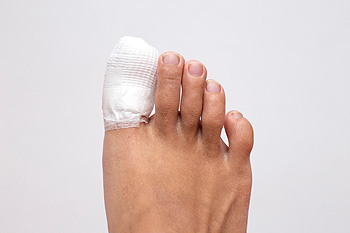 Broken toes often result from trauma. They may occur from dropping something directly on the toes, stubbing a toe, or bending them the wrong way. Toes can also break due to a stress fracture after a sudden increase in activity. The common indications of a broken toe include a snapping or popping sound at the time of the injury, swelling, bruising, and pain that becomes worse when the toe is moved. Patients who notice these symptoms may have a broken toe and would be wise to see a podiatrist who can assess the injury. A podiatrist will need to take an x-ray, and if a broken toe is confirmed, they can determine the best course for treatment. Depending on the nature of the break, the toe can be “buddy-taped” to the uninjured toe next to it, placed in a cast, or in severe cases surgery may be required.
Broken toes often result from trauma. They may occur from dropping something directly on the toes, stubbing a toe, or bending them the wrong way. Toes can also break due to a stress fracture after a sudden increase in activity. The common indications of a broken toe include a snapping or popping sound at the time of the injury, swelling, bruising, and pain that becomes worse when the toe is moved. Patients who notice these symptoms may have a broken toe and would be wise to see a podiatrist who can assess the injury. A podiatrist will need to take an x-ray, and if a broken toe is confirmed, they can determine the best course for treatment. Depending on the nature of the break, the toe can be “buddy-taped” to the uninjured toe next to it, placed in a cast, or in severe cases surgery may be required.
Broken toes may cause a lot of pain and should be treated as soon as possible. If you have any concerns about your feet, contact one of our podiatrists from New Tampa Foot & Ankle. Our doctors will treat your foot and ankle needs.
What Is a Broken Toe?
A broken toe occurs when one or more of the toe bones of the foot are broken after an injury. Injuries such as stubbing your toe or dropping a heavy object on it may cause a toe fracture.
Symptoms of a Broken Toe
- Swelling
- Pain (with/without wearing shoes)
- Stiffness
- Nail Injury
Although the injured toe should be monitored daily, it is especially important to have a podiatrist look at your toe if you have severe symptoms. Some of these symptoms include worsening or new pain that is not relieved with medication, sores, redness, or open wounds near the toe.
If you have any questions, please feel free to contact our office located in Wesley Chapel, FL . We offer the newest diagnostic and treatment technologies for all your foot care needs.
How Neuropathy Affects Feet
 Neuropathy occurs when the nerves in the hands and feet get damaged. This usually causes the extremities affected to lose their sensation and feeling, thus their ability to feel pain and temperature. Numbness, tingling, a burning/stabbing pain, and weakness are all also common signs of neuropathy. Neuropathy can have a variety of causes including inflammatory diseases, kidney problems, and vitamin deficiencies, but the most common cause is diabetes. Because of this, diabetic patients should also have regular checkups with a podiatrist to monitor the potential development of neuropathy. If you are noticing the symptoms of neuropathy in your feet, please consult with a podiatrist for a proper diagnosis and treatment method.
Neuropathy occurs when the nerves in the hands and feet get damaged. This usually causes the extremities affected to lose their sensation and feeling, thus their ability to feel pain and temperature. Numbness, tingling, a burning/stabbing pain, and weakness are all also common signs of neuropathy. Neuropathy can have a variety of causes including inflammatory diseases, kidney problems, and vitamin deficiencies, but the most common cause is diabetes. Because of this, diabetic patients should also have regular checkups with a podiatrist to monitor the potential development of neuropathy. If you are noticing the symptoms of neuropathy in your feet, please consult with a podiatrist for a proper diagnosis and treatment method.
Neuropathy
Neuropathy can be a potentially serious condition, especially if it is left undiagnosed. If you have any concerns that you may be experiencing nerve loss in your feet, consult with one of our podiatrists from New Tampa Foot & Ankle. Our doctors will assess your condition and provide you with quality foot and ankle treatment for neuropathy.
What Is Neuropathy?
Neuropathy is a condition that leads to damage to the nerves in the body. Peripheral neuropathy, or neuropathy that affects your peripheral nervous system, usually occurs in the feet. Neuropathy can be triggered by a number of different causes. Such causes include diabetes, infections, cancers, disorders, and toxic substances.
Symptoms of Neuropathy Include:
- Numbness
- Sensation loss
- Prickling and tingling sensations
- Throbbing, freezing, burning pains
- Muscle weakness
Those with diabetes are at serious risk due to being unable to feel an ulcer on their feet. Diabetics usually also suffer from poor blood circulation. This can lead to the wound not healing, infections occurring, and the limb may have to be amputated.
Treatment
To treat neuropathy in the foot, podiatrists will first diagnose the cause of the neuropathy. Figuring out the underlying cause of the neuropathy will allow the podiatrist to prescribe the best treatment, whether it be caused by diabetes, toxic substance exposure, infection, etc. If the nerve has not died, then it’s possible that sensation may be able to return to the foot.
Pain medication may be issued for pain. Electrical nerve stimulation can be used to stimulate nerves. If the neuropathy is caused from pressure on the nerves, then surgery may be necessary.
If you have any questions, please feel free to contact our office located in Wesley Chapel, FL . We offer the newest diagnostic and treatment technologies for all your foot care needs.
Risk Factors for Ankle Sprains and Strains
The ankles are incredible joints that allow us to move our feet. Unfortunately, these joints are frequently the site of sprains or strains. An ankle sprain is rather common and occurs when a ligament in the ankle is overstretched or torn. A strain is not as frequent, and they develop when one of the muscles or tendons in the ankle become overstretched or torn. Certain factors can increase one’s risk of sustaining an ankle sprain or strain. These may include exercising with poor athletic conditioning, not warming up or stretching properly prior to beginning or ending a new activity, continuing to exercise despite muscle and ligament fatigue, carrying excess weight, and wearing non-supportive or ill-fitting shoes. If you are experiencing any type of ankle pain, please seek the care of a podiatrist as soon as possible.
Ankle pain can be caused by a number of problems and may be potentially serious. If you have ankle pain, consult with one of our podiatrists from New Tampa Foot & Ankle. Our doctors will assess your condition and provide you with quality foot and ankle treatment.
Ankle pain is any condition that causes pain in the ankle. Due to the fact that the ankle consists of tendons, muscles, bones, and ligaments, ankle pain can come from a number of different conditions.
Causes
The most common causes of ankle pain include:
- Types of arthritis (rheumatoid, osteoarthritis, and gout)
- Ankle sprains
- Broken ankles
- Achilles tendinitis
- Achilles tendon rupture
- Stress fractures
- Bursitis
- Tarsal tunnel syndrome
- Plantar fasciitis
Symptoms
Symptoms of ankle injury vary based upon the condition. Pain may include general pain and discomfort, swelling, aching, redness, bruising, burning or stabbing sensations, and/or loss of sensation.
Diagnosis
Due to the wide variety of potential causes of ankle pain, podiatrists will utilize a number of different methods to properly diagnose ankle pain. This can include asking for personal and family medical histories and of any recent injuries. Further diagnosis may include sensation tests, a physical examination, and potentially x-rays or other imaging tests.
Treatment
Just as the range of causes varies widely, so do treatments. Some more common treatments are rest, ice packs, keeping pressure off the foot, orthotics and braces, medication for inflammation and pain, and surgery.
If you have any questions, please feel free to contact our office located in Wesley Chapel, FL . We offer the newest diagnostic and treatment technologies for all your foot care needs.
